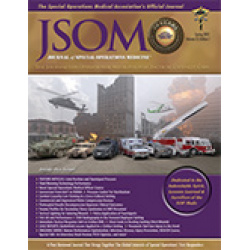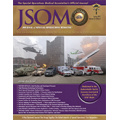The Use of Chest Seals in Treating Sucking Chest Wounds: A Comparison of Existing Evidence and Guideline Recommendations
Kuhlwilm V 21(1). 94 - 101 (Journal Article)
Introduction: Sucking chest wounds occur when injuries penetrate the thorax and inhalation results in air entering the pleural cavity. Well documented in the prehospital environment, treatment should be chest seal application to attempt prevention of an expanding pneumothorax. However, a seal might occlude the pathway for the escape of air and lead to a worsening tension pneumothorax. Methods: The author conducted a literature search of studies reporting the efficacy of various chest seals for treating sucking chest wounds and the prevention of a tension pneumothorax. Study results were compared to current international guidelines. Results/Discussion: Included were four studies testing chest seals in a swine model of hemopneumothorax. Vented and unvented chest seals stabilized cardiorespiratory parameters after an open pneumothorax, but only vented chest seals showed more success at preventing a tension pneumothorax. Chest seals with flutter valves seemed to be inferior. An additional study showed that vertical movements and soiled skin were more stressful on the applied chest seals. Eight international guidelines were identified: four focused on the tactical environment, and four appeared to be more civilian-oriented. Only two of the civilian-oriented guidelines did not prefer vented chest seals. Conclusion: Vented chest seals seem to be superior to unvented chest seals, and most international guidelines have updated their recommendations for the use of vented chest seals. However, frequent physical examinations for early signs of a developing or worsening tension pneumothorax are the best medical care.


 English
English 




